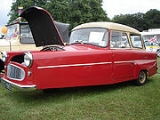
Bond Cars Ltd
Encyclopedia
Bond Cars Ltd was a British
car
maker. Initially called Sharps Commercials Ltd, it changed its name to Bond Cars Ltd in 1963. The company was taken over by the Reliant Motor Co Ltd
of Tamworth
, Staffs
in 1970 who quickly closed the Preston factory, transferring the spare parts business for the Bond Minicar, 875 saloon, 875 Ranger van and Equipe models to a firm called Bob Joyner & Son in Oldbury
in the English Midlands
. Reliant nevertheless continued to use the Bond name until 1974 on Bond Bug
models made at their own Tamworth plant.
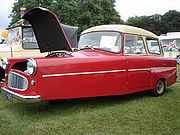 Sharp's Commercials began production of an economical three-wheeled car early in 1949. It was called the "Bond Minicar" (retrospectively to be called the Mark A) and was powered by a single-cylinder
Sharp's Commercials began production of an economical three-wheeled car early in 1949. It was called the "Bond Minicar" (retrospectively to be called the Mark A) and was powered by a single-cylinder
two-stroke
Villiers
engine of 122 or 197 cc. Bodywork was mostly aluminium
, though some later models used fibreglass for parts of the car. It proved very popular at the time owing to post-war economies.
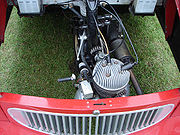 The Minicar moved on through several different incarnations, culminating in the "Mark G" in 1961. Convertible
The Minicar moved on through several different incarnations, culminating in the "Mark G" in 1961. Convertible
s were offered, as were van
and estate
versions. The engine was upgraded, first to a single-cylinder 250 cc and then to a 250 cc twin-cylinder Villiers 4T (optional on the Mark G). The engines were essentially motorcycle units and therefore had no reverse gear. However, this was a minimal inconvenience, because the engine, gearbox and front wheel were mounted as a single unit and could be turned by the steering wheel up to 90 degrees either side of the straight-ahead position, enabling the car to turn within its own length.
Reverse gear of a sort was offered on later models, but using this involved stopping the engine and starting it backwards. This was done by reversing the Siba Dynastart unit, a device which doubled as both starter and generator. It operated as a starter motor when the starter button was pressed but when the engine was running it generated power instead and recharged the battery.
The last Bond Minicar, a Mark G, was made in November 1966.
 The Equipe GT was Bond's first four wheel car, a sports car
The Equipe GT was Bond's first four wheel car, a sports car
, with fibreglass two door body fitted on the Triumph Herald
chassis
with the Triumph Spitfire
1147 cc engine This was replaced by the GT4S model in 1964, offering 4 seats, an opening boot lid and twin headlights. A 1296cc engine was introduced in 1967.
Also in 1967, the new Equipe 2 Litre was introduced, based on styling proposals by Trevor Fiore. This has the six-cylinder 2-litre Triumph Vitesse
chassis and engine, uprated to the Mk.2 version in 1968, at which time a convertible version was also offered.
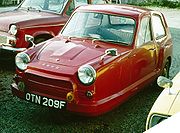 The Bond 875 was three-wheeler with a rear-mounted
The Bond 875 was three-wheeler with a rear-mounted
four-cylinder 875 cc four-stroke engine Hillman Imp
-derived Commer
van engine. It was dropped from the range in 1970 when Reliant took over the company.
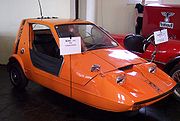 The Bond Bug was perhaps the best known of the company's creations, this was, again, a three-wheeler but with a Reliant 700 cc four-cylinder engine and a top speed of 75 mi/h. Most were finished in bright orange, and with a body styled by Tom Karen of Ogle Design
The Bond Bug was perhaps the best known of the company's creations, this was, again, a three-wheeler but with a Reliant 700 cc four-cylinder engine and a top speed of 75 mi/h. Most were finished in bright orange, and with a body styled by Tom Karen of Ogle Design
were a fashion statement in the 1970s. Entry was gained by swinging the roof forwards on a front hinge.
tent
s, suitcases, etc.
United Kingdom
The United Kingdom of Great Britain and Northern IrelandIn the United Kingdom and Dependencies, other languages have been officially recognised as legitimate autochthonous languages under the European Charter for Regional or Minority Languages...
car
Automobile
An automobile, autocar, motor car or car is a wheeled motor vehicle used for transporting passengers, which also carries its own engine or motor...
maker. Initially called Sharps Commercials Ltd, it changed its name to Bond Cars Ltd in 1963. The company was taken over by the Reliant Motor Co Ltd
Reliant
Reliant was a British car manufacturer. The company was traditionally based at Tamworth in Staffordshire, England, but in 2001 it moved to nearby Cannock. It ceased manufacturing cars shortly afterwards.-History:...
of Tamworth
Tamworth
Tamworth is a town and local government district in Staffordshire, England, located north-east of Birmingham city centre and north-west of London. The town takes its name from the River Tame, which flows through the town, as does the River Anker...
, Staffs
Staffordshire
Staffordshire is a landlocked county in the West Midlands region of England. For Eurostat purposes, the county is a NUTS 3 region and is one of four counties or unitary districts that comprise the "Shropshire and Staffordshire" NUTS 2 region. Part of the National Forest lies within its borders...
in 1970 who quickly closed the Preston factory, transferring the spare parts business for the Bond Minicar, 875 saloon, 875 Ranger van and Equipe models to a firm called Bob Joyner & Son in Oldbury
Oldbury
Oldbury may refer to:*Oldbury, Western Australia, a district south of Perth, Australia*Oldbury, Shropshire, a village near Bridgnorth, England, UK*Oldbury, South Gloucestershire, a village south of Bridgnorth, England, UK...
in the English Midlands
Worcestershire
Worcestershire is a non-metropolitan county, established in antiquity, located in the West Midlands region of England. For Eurostat purposes it is a NUTS 3 region and is one of three counties that comprise the "Herefordshire, Worcestershire and Warwickshire" NUTS 2 region...
. Reliant nevertheless continued to use the Bond name until 1974 on Bond Bug
Bond Bug
The Bond Bug was a small British two seat, three wheeled sports car of the 1970s. Following the purchase of Bond Cars Limited, Reliant commissioned Tom Karen of Ogle Design to design a fun car. It was a wedge-shaped microcar, with a lift-up canopy and side screens instead of conventional doors...
models made at their own Tamworth plant.
Bond Minicar 1949 - 1966

Cylinder (engine)
A cylinder is the central working part of a reciprocating engine or pump, the space in which a piston travels. Multiple cylinders are commonly arranged side by side in a bank, or engine block, which is typically cast from aluminum or cast iron before receiving precision machine work...
two-stroke
Two-stroke cycle
A two-stroke engine is an internal combustion engine that completes the process cycle in one revolution of the crankshaft...
Villiers
Villiers Engineering
Villiers Engineering was a manufacturer of motorcycles and cycle parts, and an engineering company based in Villiers Street, Wolverhampton, England....
engine of 122 or 197 cc. Bodywork was mostly aluminium
Aluminium
Aluminium or aluminum is a silvery white member of the boron group of chemical elements. It has the symbol Al, and its atomic number is 13. It is not soluble in water under normal circumstances....
, though some later models used fibreglass for parts of the car. It proved very popular at the time owing to post-war economies.

Convertible
A convertible is a type of automobile in which the roof can retract and fold away having windows which wind-down inside the doors, converting it from an enclosed to an open-air vehicle...
s were offered, as were van
Van
A van is a kind of vehicle used for transporting goods or groups of people.In British English usage, it can be either specially designed or based on a saloon or sedan car, the latter type often including derivatives with open backs...
and estate
Station wagon
A station wagon is a body style variant of a sedan/saloon with its roof extended rearward over a shared passenger/cargo volume with access at the back via a third or fifth door , instead of a trunk lid...
versions. The engine was upgraded, first to a single-cylinder 250 cc and then to a 250 cc twin-cylinder Villiers 4T (optional on the Mark G). The engines were essentially motorcycle units and therefore had no reverse gear. However, this was a minimal inconvenience, because the engine, gearbox and front wheel were mounted as a single unit and could be turned by the steering wheel up to 90 degrees either side of the straight-ahead position, enabling the car to turn within its own length.
Reverse gear of a sort was offered on later models, but using this involved stopping the engine and starting it backwards. This was done by reversing the Siba Dynastart unit, a device which doubled as both starter and generator. It operated as a starter motor when the starter button was pressed but when the engine was running it generated power instead and recharged the battery.
The last Bond Minicar, a Mark G, was made in November 1966.
Bond Equipe 1963 - 1970

Sports car
A sports car is a small, usually two seat, two door automobile designed for high speed driving and maneuverability....
, with fibreglass two door body fitted on the Triumph Herald
Triumph Herald
The Triumph Herald was a small two-door car introduced in 1959 by the Standard-Triumph Company of Coventry. Body design was by the Italian stylist Michelotti and the car was offered in saloon, convertible, coupé, van, and estate models....
chassis
Chassis
A chassis consists of an internal framework that supports a man-made object. It is analogous to an animal's skeleton. An example of a chassis is the underpart of a motor vehicle, consisting of the frame with the wheels and machinery.- Vehicles :In the case of vehicles, the term chassis means the...
with the Triumph Spitfire
Triumph Spitfire
The Triumph Spitfire is a small English two-seat sports car, introduced at the London Motor Show in 1962. The vehicle was based on a design produced for Standard-Triumph in 1957 by Italian designer Giovanni Michelotti...
1147 cc engine This was replaced by the GT4S model in 1964, offering 4 seats, an opening boot lid and twin headlights. A 1296cc engine was introduced in 1967.
Also in 1967, the new Equipe 2 Litre was introduced, based on styling proposals by Trevor Fiore. This has the six-cylinder 2-litre Triumph Vitesse
Triumph Vitesse
The Triumph Vitesse was a compact six-cylinder car built by Standard-Triumph from 1962 to 1971. The car was styled by Michelotti, and was available in saloon and convertible variants....
chassis and engine, uprated to the Mk.2 version in 1968, at which time a convertible version was also offered.
Bond 875 1965 - 1970

RR layout
In automotive design, a RR, or Rear-engine, Rear-wheel drive layout places both the engine and drive wheels at the rear of the vehicle. In contrast to the RMR layout, the center of mass of the engine is between the rear axle and the rear bumper....
four-cylinder 875 cc four-stroke engine Hillman Imp
Hillman Imp
The Hillman Imp is a compact, rear-engined saloon car that was manufactured under the Hillman marque by the Rootes Group from 1963 to 1976...
-derived Commer
Commer
Commer became known in later years as a maker of vans for the British Post Office—particularly the Commer FC which was introduced in 1960 with many body styles, including a 1500 cc van. After engine and interior upgrades it was renamed the PB in 1967 and the SpaceVan in 1974...
van engine. It was dropped from the range in 1970 when Reliant took over the company.
Bond Bug 1970 - 1974

Ogle Design
Ogle Design is a British design consultancy company, founded in 1954 by David Ogle, based in Letchworth, Hertfordshire.-History:* 1954 Ogle Design was founded and produced many successful designs of industrial and household products....
were a fashion statement in the 1970s. Entry was gained by swinging the roof forwards on a front hinge.
Other products
Other products produced by the company included Motorscooters, a power ski, trailerTrailer (vehicle)
A trailer is generally an unpowered vehicle pulled by a powered vehicle. Commonly, the term trailer refers to such vehicles used for transport of goods and materials....
tent
Tent
A tent is a shelter consisting of sheets of fabric or other material draped over or attached to a frame of poles or attached to a supporting rope. While smaller tents may be free-standing or attached to the ground, large tents are usually anchored using guy ropes tied to stakes or tent pegs...
s, suitcases, etc.

